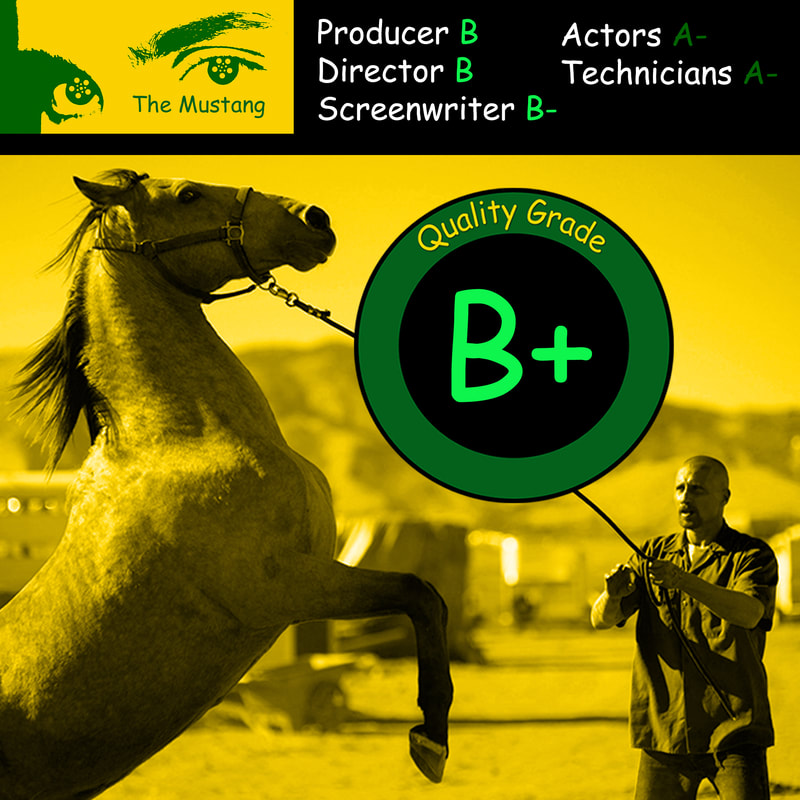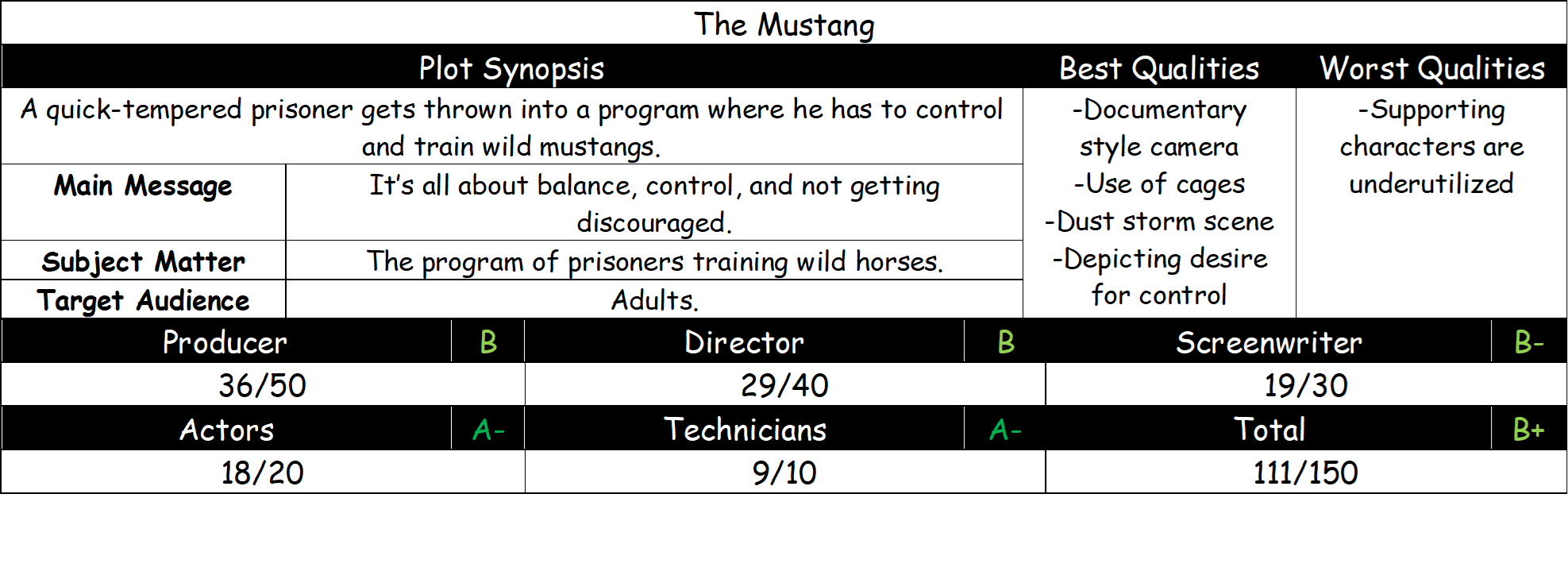Click here to see how I came up with all my scores.
Review:
Here’s what the thought process of mine was like back in middle school: back then, I thought Pixar set the golden standard of filmmaking, until Cars 2 came out the summer after my high school graduation. It gave me a much-needed reality check before entering college, which worked for the better, as once Cars 3 came out, I accepted the truth that Pixar is no different than other studios. But middle school was also the time when having a social circle was a nearly nonexistent priority until high school. The Mustang captures that sense of aloneness and desperation miraculously to the point where it makes you look back and see the now more realistically.
Being a weak conversationalist, I usually feel separated from others, similar to the fear that first time feature director Laure de Clermont-Tonnerre triggers through static sounds. She works with production designer Carlos Conti (The Motorcycle Diaries) to make barriers around a horse pen look like prison bars, or a lavender anger management room infuriate the nerves. Meanwhile, the “good guy” supervisors wear blue, so even they appear deranged. Although the prison setting could benefit from a more diverse cast to voice what political correctness of today means in that part of society, the theme of control is still more powerful than you could imagine.
The somber set designs match how I, being autistic, feel when around many people, right down to the visual stimulation. Some on the autism spectrum hate certain colors, such as yellow and brown, so likewise, the protagonist, Roman, has the same case with signs he could have a mental disability. One cut transitions him chucking a bag of chips to shoveling out dung, between these two connected activities, Roman remains of very few words while embracing crap.
He speaks more with his eyes as they bond not with people, but with a locked-up animal: The lack of trust turns apparent from outside the two long-faced eye-gazers. He is the horse, the horse is him, a concept established right away immediately upon Roman’s introductory frame, hence why this crowd-pleaser should be celebrated.
Though be warned, it’s not a traditional crowd-pleaser, as one of its modes of focus is on Roman’s daughter, who tragically let herself become pregnant. The time she spends with dad is a little too manipulative in sadness but is so core to the theme of this production that it would be criminal to leave her out.
The crowd-pleasing rather tells hard truths about inner fragility via Roman’s explosive f-bombs that beat your chest. Then your ears buzz as a traumatic dust storm breathes beneath heavy orange lights, a special effects sequence that proves how the production crew really put the best of their hands to deliver the tremendous guilt-driven moments of anger.
The technical elements paint the dangerous waters the typical man must swim across, kicked off by an annoying whistle sound heard over a helicopter chase against glorious mountains—sheer irony of chaos surrounded by glory. Then as it gets smaller in the confinement of a cell, the scope remains remarkable after Roman studies an informative magazine secretly given to him.
The camera’s motion is almost always handheld in order to express the same level of FOMO discouragement you’d feel after spending too much time on a Facebook wall. It’s done in that lavender room as the camera pans past each unnamed anger management patient individually until it stops at Roman. These men, along with his underused cell mate, prove a couple of missed opportunities in generating deeper insight of Roman’s outside influence, but that pressure is still beyond clear due to the harsh sunlight that beats down on him to challenge what he can handle.
Life benefits from having others around, which explains my depressed feelings from struggling to form solid bonds. Pixar’s filmography has ironically coincided exactly with what I’m going through at the time, right down to teaching me at age six that people over time will eventually leave. Of course, the summer before senior year, by the time the Toy Story trilogy was concluded, it felt like my childhood was over, as I knew I soon had to start over again with finding love from other places.
The Mustang is guaranteed to help you grasp that same somber, reflective sorrow needed to find a permanent place of belonging past iron and concrete.
Here’s what the thought process of mine was like back in middle school: back then, I thought Pixar set the golden standard of filmmaking, until Cars 2 came out the summer after my high school graduation. It gave me a much-needed reality check before entering college, which worked for the better, as once Cars 3 came out, I accepted the truth that Pixar is no different than other studios. But middle school was also the time when having a social circle was a nearly nonexistent priority until high school. The Mustang captures that sense of aloneness and desperation miraculously to the point where it makes you look back and see the now more realistically.
Being a weak conversationalist, I usually feel separated from others, similar to the fear that first time feature director Laure de Clermont-Tonnerre triggers through static sounds. She works with production designer Carlos Conti (The Motorcycle Diaries) to make barriers around a horse pen look like prison bars, or a lavender anger management room infuriate the nerves. Meanwhile, the “good guy” supervisors wear blue, so even they appear deranged. Although the prison setting could benefit from a more diverse cast to voice what political correctness of today means in that part of society, the theme of control is still more powerful than you could imagine.
The somber set designs match how I, being autistic, feel when around many people, right down to the visual stimulation. Some on the autism spectrum hate certain colors, such as yellow and brown, so likewise, the protagonist, Roman, has the same case with signs he could have a mental disability. One cut transitions him chucking a bag of chips to shoveling out dung, between these two connected activities, Roman remains of very few words while embracing crap.
He speaks more with his eyes as they bond not with people, but with a locked-up animal: The lack of trust turns apparent from outside the two long-faced eye-gazers. He is the horse, the horse is him, a concept established right away immediately upon Roman’s introductory frame, hence why this crowd-pleaser should be celebrated.
Though be warned, it’s not a traditional crowd-pleaser, as one of its modes of focus is on Roman’s daughter, who tragically let herself become pregnant. The time she spends with dad is a little too manipulative in sadness but is so core to the theme of this production that it would be criminal to leave her out.
The crowd-pleasing rather tells hard truths about inner fragility via Roman’s explosive f-bombs that beat your chest. Then your ears buzz as a traumatic dust storm breathes beneath heavy orange lights, a special effects sequence that proves how the production crew really put the best of their hands to deliver the tremendous guilt-driven moments of anger.
The technical elements paint the dangerous waters the typical man must swim across, kicked off by an annoying whistle sound heard over a helicopter chase against glorious mountains—sheer irony of chaos surrounded by glory. Then as it gets smaller in the confinement of a cell, the scope remains remarkable after Roman studies an informative magazine secretly given to him.
The camera’s motion is almost always handheld in order to express the same level of FOMO discouragement you’d feel after spending too much time on a Facebook wall. It’s done in that lavender room as the camera pans past each unnamed anger management patient individually until it stops at Roman. These men, along with his underused cell mate, prove a couple of missed opportunities in generating deeper insight of Roman’s outside influence, but that pressure is still beyond clear due to the harsh sunlight that beats down on him to challenge what he can handle.
Life benefits from having others around, which explains my depressed feelings from struggling to form solid bonds. Pixar’s filmography has ironically coincided exactly with what I’m going through at the time, right down to teaching me at age six that people over time will eventually leave. Of course, the summer before senior year, by the time the Toy Story trilogy was concluded, it felt like my childhood was over, as I knew I soon had to start over again with finding love from other places.
The Mustang is guaranteed to help you grasp that same somber, reflective sorrow needed to find a permanent place of belonging past iron and concrete.
Thanks so much for your time in reading! Please subscribe to my site for more updates on reviews.
If there is a specific movie you’d like to see graded, or if you are interested in guest blogging for my site, please email me at [email protected] for your recommendations.
Have a great weekend, and happy watching!
If there is a specific movie you’d like to see graded, or if you are interested in guest blogging for my site, please email me at [email protected] for your recommendations.
Have a great weekend, and happy watching!
Sources:
Gleiberman, Owen. “Film Review: ‘The Mustang’.” Digital image. Variety. Penske Business Media, 1 Feb 2019. Web. <https://variety.com/2019/film/reviews/the-mustang-review-matthias-schoenaerts-1203126411/>.
Mustang, The. Focus Features. Web. <http://focusfeatures.com/the-mustang>.
Gleiberman, Owen. “Film Review: ‘The Mustang’.” Digital image. Variety. Penske Business Media, 1 Feb 2019. Web. <https://variety.com/2019/film/reviews/the-mustang-review-matthias-schoenaerts-1203126411/>.
Mustang, The. Focus Features. Web. <http://focusfeatures.com/the-mustang>.


 RSS Feed
RSS Feed
